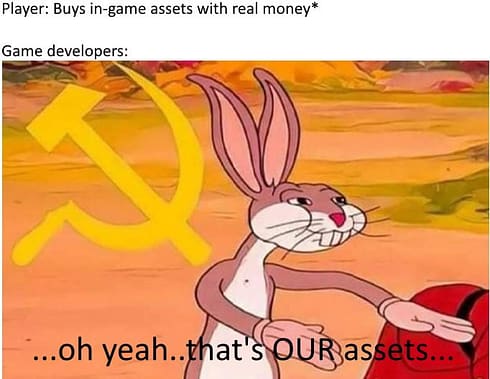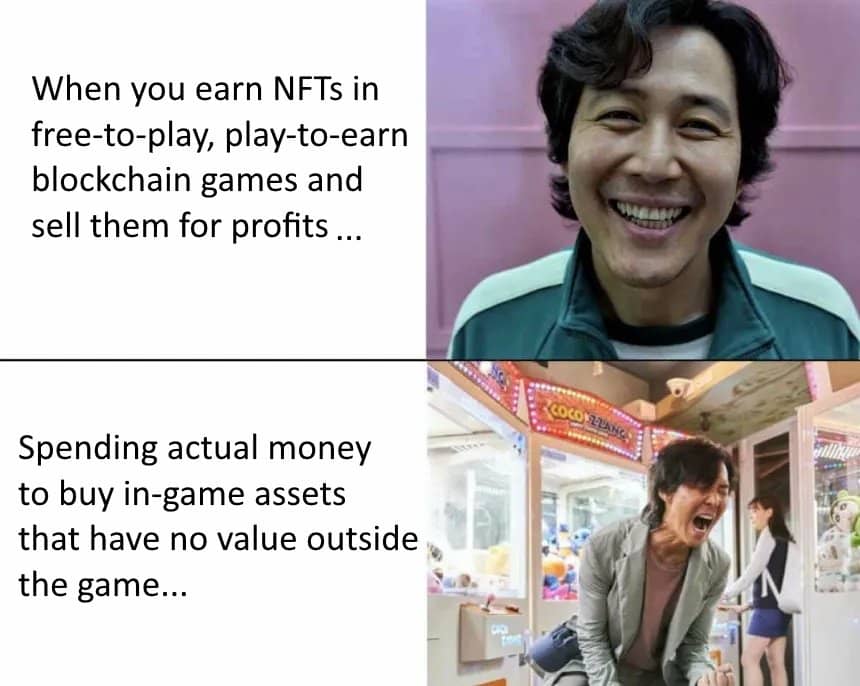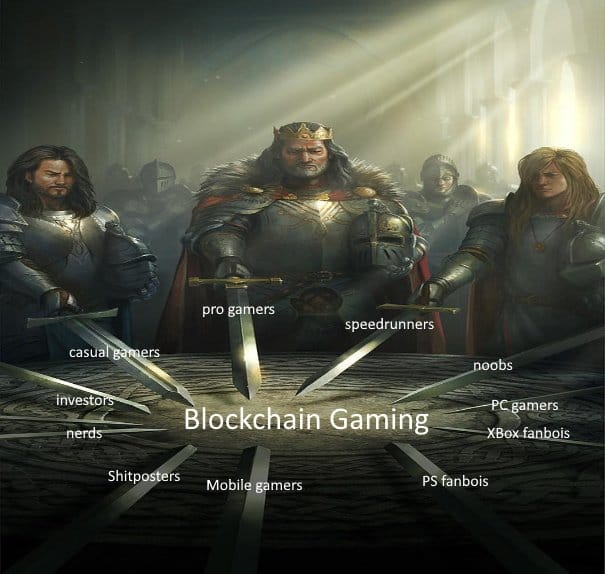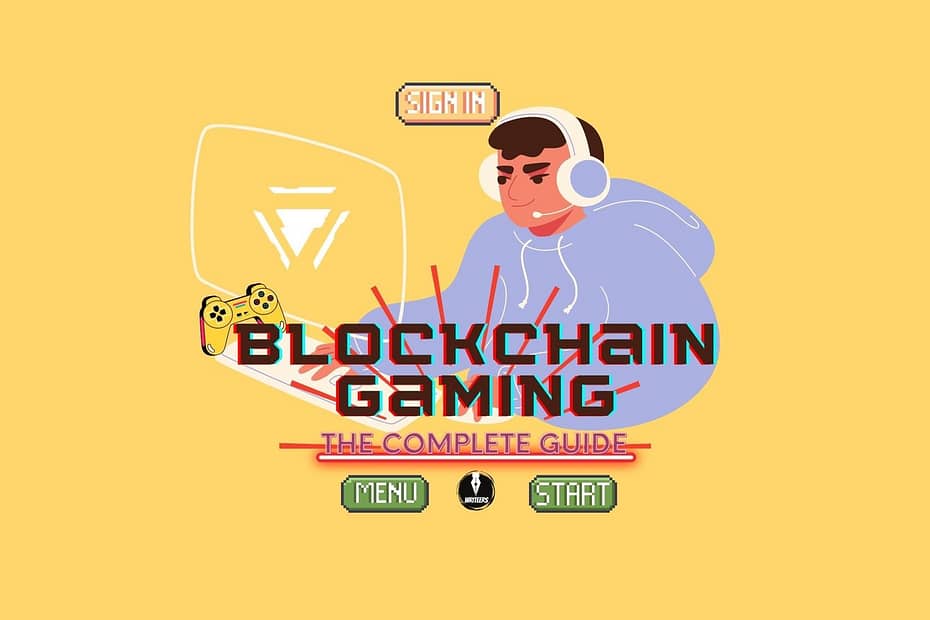“Blockchain gaming” is the talk of the town these days!
Everyone is talking about them – from professional gamers to casual gamers, and even the ones that have never played any game (except for Candy Crush) in their entire lives.
As cryptocurrencies and the underlying blockchain technology continue to gain mainstream attention, traditional industries all over the world are trying to find innovative ways to incorporate this revolutionary technology into their business models.
Among the many industries that are exploring the potential of blockchain, the gaming industry has become the breeding ground for a ton of amazing innovations. By merging blockchain technology with traditional gaming models, a new genre called GameFi has emerged, showcasing a totally new use case for cryptocurrencies.
So, without any further ado, let’s help you understand what blockchain gaming is, how blockchain gaming works, and how you can make money by just playing these games.
Table of Contents
What Is Blockchain Gaming?
Simply put, blockchain gaming is the gaming niche where all games are created using blockchain technology. It leverages blockchain’s inherent features of decentralization, immutability, security, and transparency to offer player provably fair gaming environments as well as “true ownership” of in-game assets.
To better understand this concept, you need to first realize how the traditional gaming economy works. In almost every traditional game like Call Of Duty, GTA, Fortnite, or PUBG, there is this concept of microtransactions. Players can buy in-game assets like XP, battle passes, legendary weapons, characters, and skins, and much more using the game’s in-game currency.

To purchase these in-game currencies, players must spend actual money (fiat currencies). However, even after purchasing these assets, players don’t usually have full ownership of these items. For instance, the “legendary sniper” that you purchased in a game can’t be sold or rented out to other players, even when you’ve bored yourself playing with it. Additionally, your “purchased” assets are stored in centralized servers, and the game developers usually have full control over it.
What if the game servers get hacked?
Or the company decides to shut down the game?
Poof!
Your “in-game assets” are gone! Just like that.
This is a problem, right?
The answer to this problem is blockchain gaming. In a blockchain game, each player owns a portion of the game, that too, without any centralized authorities. Imagine being able to sell and rent the in-game assets you own or transferring the winnings from one game to another – yeah, blockchain gaming makes this possible.

Blockchain gaming introduces the concept of Free-to-play (F2P), Play-to-earn (P2E), where anyone can register and play without buying anything. Instead, by playing these games, users can win free NFTs (non-fungible tokens), collectibles, and other assets that hold real monetary value, both in the game and outside the game.
Other than this, blockchain gaming also offers the Pay-to-earn mode, where users need to make an initial deposit, usually by purchasing any in-game asset, and GameFi, which is a mix of gaming and decentralized finance (DeFi). Both play-to-earn and pay-to-earn models fall under GameFi, an ecosystem that enables players to earn by playing games.
How Blockchain Gaming Works?
Essentially, a blockchain is “network of data blocks” built using a peer-to-peer-connected devices that is open to all of its participants and everyone else. Public blockchains are fully decentralized, transparent, and immutable. Using these features, anyone can build a blockchain game where there is no centralized authority.
A blockchain game consists of three core components (in addition to the game theory itself). These include:
- Smart Contracts – digital agreements that control all actions within the game
- NFTs – digital collectibles and in-game assets with intrinsic value that gives its users full ownership
- In-game Currency (Tokenomics) – the digital token that is used for all actions within the game
Take for instance, the popular mobile game “Merge Cats” developed by Sergey Zasorin. In this game, all you need to do is collect cats, merge them to make them stronger, and continue levelling up. For every round you clear, you earn the platform’s Substrate-based native token LIS. Additionally, the game also offers free NFTs, which players can withdraw to their personal wallets at any time.
This simple yet engaging and rewarding game is a great example to get yourself acquainted with the concept of blockchain gaming before you start playing bigger games like Axie Infinity and Splinterlands.

In essence, when you play any blockchain game, you aren’t just a player. Instead, you own a portion of the game. And as an owner, you have the rights to do whatever you want to do with assets that you own.
For example, you can sell any NFT that you have earned from a game in secondary marketplaces like OpenSea and Rarible or other marketplaces offered by the game itself. Alternatively, you can add your NFTs to lending pools and earn interest on them. You can even rent out your assets to other players for a fixed period and earn great returns on your investment.
TL; DR: Blockchain gaming doubles up as investment opportunities. Depending on the rarity and demand of assets that you own, there is no limit to the money you can make. (tell this to your parents and they will think twice before dissing your for playing games all day long).
The Blockchain Gaming Market
NFTs play a critical role in the expanding gaming market. If current trends continue, blockchain-based gaming may prove to be an attractive crypto-use case that displaces the traditional global gaming industry.
Currently, the NFT and collectible tokens market cap stands at $65, 282, 011, 907, with prominent blockchain games like Axie Infinity, Decentraland, The Sandbox, Gala, and Enjin cementing themselves in the top-10 list.
Things are poised to explode in 2022 as the highly anticipated “metaverse” aims to bring more interoperability and cross-play between individual blockchain games, thus giving more utility to the assets that players already own. All of the blockchain games and the NFTs (and other decentralized assets) can be moved seamlessly from one platform to another as long as they are connected to a blockchain network. This will enable game creators and gamers build a fully functioning virtual economy, which has the potential to change the lives of millions of people worldwide.
In fact, a recent report by CNN indicates that during the hardships of COVID-19, people from several counties started playing these play-to-earn games, earning decent income to support themselves and their families.
The traditional gaming industry is already a multi-billion-dollar industry. Experts predict that the global gaming market is expected to reach a value of USD 314.40 billion by 2026, registering a CAGR of 9.64% over 2021-2026.
At the same time, data published by the Blockchain Gaming Alliance for Q3, 2021, highlights that in Q3, the Unique Active Wallets (UAW) connected to game dApps reached 754,000, which represents almost half of the industry’s activity. In the same period, in-game NFTs accounted for more than 20% of the record Q3 NFT trading volume, generating $2.32 billion in sales.
Imagine how these numbers would swell when more blockchain games enter the mainstream gaming industry.
Why Blockchain Gaming Is The Future?
Blockchain technology is evolving at an unprecedented rate. As such, it is well equipped to facilitate traditional gaming in several areas, including:
- Scalability – Next-gen blockchain networks offer great scalability, which will help game developers adapt to the changing needs of the players. Since the underlying technology is highly scalable, game files and in-game data (assets, XP, NFTs, etc.) can be easily accommodated as the community grows.
- Transparency and Security – All transactions on blockchain networks are recorded in a distributed leger, which is open to the public. Hence, blockchain games lower the chances of cheating or unfair practices by maintaining epic levels of transparency. Besides, all records on the ledger are immutable, which adds to an additional layer of security.
- Cost–Efficiency – Public blockchains are open-source, which allows anyone to build games on them. For instance, if someone is building on Ethereum, much of their operating and capital costs are obliterated as Ethereum is free-to-use (except for the gas costs). Lower cost enables greater participation, which is a must for any industry to thrive.
- Earning Opportunities – Imagine spending thousands of dollars to equip your avatar with the best assets and then realizing that you can’t ever recoup the money you invested. Blockchain games give you access to several earning opportunities, including buying, selling, renting, lending, and trading your in-game assets, both inside the game and on secondary marketplaces.
- True Ownership – Even after spending time and money, players never actually own anything in the traditional games. They serve no purpose outside of the game’s virtual environment. Blockchain games turn this practice heads down by adding monetary value to each in-game item via NFTs. Not only do players own 100% of the item, but they also are able to sell it or trade it as and when needed.
- Decentralized and Permissionless – No centralized control whatsoever. The smart contracts do the needful without anyone controlling them. As a result, each participant owns a portion of the game.
In addition to this, several add-on initiatives like decentralized content streaming, content sharing, and other niches that are related to gaming have also emerged because of blockchain’s merger with the trading gaming industry. Both these industries are thriving and are here to stay for a long time; hence, the crossover will set the foundation for a new era of gaming.
Top 5 Blockchain Games To Play Right Now
There are hundreds of blockchain games, with dozens of new games launched every day. That said, here are a few games that are currently dominating the blockchain gaming industry:
- Axie Infinity – Axie Infinity (AXS) brings the traditional card-based trading and battling game on the blockchain. It is one of the highest played games this year and is inspired by other popular games like Pokemon and Tamagotchi. Currently, the AXS token is valued at $118.49 each.
- Splinterlands – Splinterlands is an amazing play-to-earn NFT game and one of the most active NFT-card games of 2021. With more than 360K users, Splinterlands brings the best of Pokemon card games and World of Warcraft characters onto the blockchain. The platform also has its own in-game economy, DEC (Dark Energy Crystals), valued at $0.0089 per token.
- Gala – Gala is more of an NFT-gaming ecosystem. It offers a collection of 100% free-to-play, play-to-earn games such as Spider Tank, Mirandus, Fortified, Town Star, and Echoes of Empires, alongside a full-fledged NFT marketplace. The platform’s native token, GALA, is currently valued at $0.52 each.
- Decentraland – Decentraland is a virtual reality (VR) platform built on the Ethereum blockchain. It allows players to purchase virtual assets, which they can later monetize. The platform offers an ERC-20 token, MANA, currently valued at $3.80 each, and non-fungible ERC-721 token, LAND.
- The Sandbox – Sandbox is another virtual world that brings the best of DAO (decentralized autonomous organizations) and NFTs for users. In this blockchain game, you can create, build, buy, and sell assets. The Sandbox also offers its native token, SAND, currently valued at $5.62 each.
Conclusion
Blockchain technology has already made a significant impact in the traditional gaming industry. From offering true ownership of assets, to allowing players to tap into several revenue sources while, blockchain gaming is redefining the existing gaming model, cementing itself as the catalyst that will help the video gaming industry adapt to the changing needs of their user communities.
Besides, leading traditional gaming companies like Xbox, Twitch, and G2A have also started entering the crypto gaming scene, which will play a significant role in helping blockchain gaming appeal to the masses. As such, it is no hyperbole to claim that blockchain gaming is the future of gaming and that metaverse and NFT tokens will contribute immensely towards the next “crypto bull cycle.”
FAQs
1. What is blockchain gaming?
These days a lot of games are being built on blockchain networks. These games offer players full ownership of the in-game assets they earn or purchase, allowing them to generate revenue while playing their favorite games. This emerging niche is called blockchain gaming.
2. What is the best NFT game?
Depends on your gaming preferences. If you want to go by numbers, Splinterlands and Axie Infinity are the two most-played NFT games.
3. Is there a free NFT game?
Yes, there are dozens of free-to-play, play-to-earn blockchain and NFT games.
4. How can I earn money from blockchain gaming?
Simple, play the game and collect the NFTs. You can then sell, lend, rent, or trade them with other players within the game or in secondary marketplaces.
5. How big is the blockchain gaming industry?
As per Q3 data from the Blockchain Gaming Alliance, in-game NFT collectibles generated $2.32 billion in sales during Q3.

